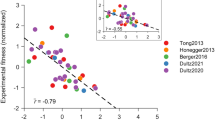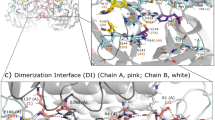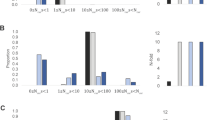Abstract
The development of a quantitative understanding of viral evolution and the fitness landscape in HIV-1 drug resistance is a formidable challenge given the large number of available drugs and drug resistance mutations. We analyzed a dataset measuring the in vitro fitness of 70,081 virus samples isolated from HIV-1 subtype B infected individuals undergoing routine drug resistance testing. We assayed virus samples for in vitro replicative capacity in the absence of drugs as well as in the presence of 15 individual drugs. We employed a generalized kernel ridge regression to estimate main fitness effects and epistatic interactions of 1,859 single amino acid variants found within the HIV-1 protease and reverse transcriptase sequences. Models including epistatic interactions predict an average of 54.8% of the variance in replicative capacity across the 16 different environments and substantially outperform models based on main fitness effects only. We find that the fitness landscape of HIV-1 protease and reverse transcriptase is characterized by strong epistasis.
This is a preview of subscription content, access via your institution
Access options
Subscribe to this journal
Receive 12 print issues and online access
$209.00 per year
only $17.42 per issue
Buy this article
- Purchase on Springer Link
- Instant access to full article PDF
Prices may be subject to local taxes which are calculated during checkout



Similar content being viewed by others
References
De Clercq, E. Anti-HIV drugs: 25 compounds approved within 25 years after the discovery of HIV. Int. J. Antimicrob. Agents 33, 307–320 (2009).
Shafer, R.W. & Schapiro, J.M. HIV-1 drug resistance mutations: an updated framework for the second decade of HAART. AIDS Rev. 10, 67–84 (2008).
Clavel, F. & Hance, A.J. HIV drug resistance. N. Engl. J. Med. 350, 1023–1035 (2004).
Johnson, V.A. et al. Update of the drug resistance mutations in HIV-1. Top. HIV Med. 16, 138–145 (2008).
Bennett, D.E. et al. Drug resistance mutations for surveillance of transmitted HIV-1 drug-resistance: 2009 update. PLoS ONE 4, e4724 (2009).
Petropoulos, C.J. et al. A novel phenotypic drug susceptibility assay for human immunodeficiency virus type 1. Antimicrob. Agents Chemother. 44, 920–928 (2000).
Rhee, S.-Y., Liu, T., Ravela, J., Gonzales, M.J. & Shafer, R.W. Distribution of human immunodeficiency virus type 1 protease and reverse transcriptase mutation patterns in 4,183 persons undergoing genotypic resistance testing. Antimicrob. Agents Chemother. 48, 3122–3126 (2004).
Harrigan, P.R. & Larder, B.A. Extent of cross-resistance between agents used to treat human immunodeficiency virus type 1 infection in clinically derived isolates. Antimicrob. Agents Chemother. 46, 909–912 (2002).
Croteau, G. et al. Impaired fitness of human immunodeficiency virus type 1 variants with high-level resistance to protease inhibitors. J. Virol. 71, 1089–1096 (1997).
Martinez-Picado, J., Savara, A.V., Sutton, L. & D'Aquila, R.T. Replicative fitness of protease inhibitor-resistant mutants of human immunodeficiency virus type 1. J. Virol. 73, 3744–3752 (1999).
Mammano, F., Trouplin, V., Zennou, V. & Clavel, F. Retracing the evolutionary pathways of human immunodeficiency virus type 1 resistance to protease inhibitors: virus fitness in the absence and in the presence of drug. J. Virol. 74, 8524–8531 (2000).
Bonhoeffer, S., Chappey, C., Parkin, N.T., Whitcomb, J.M. & Petropoulos, C.J. Evidence for positive epistasis in HIV-1. Science 306, 1547–1550 (2004).
Efron, B., Hastie, T., Johnstone, I. & Tibshirani, R. Least angle regression. Ann. Stat. 32, 407–499 (2002).
Candes, E. & Tao, T. The Dantzig selector: statistical estimation when p is much larger than n. Ann. Stat. 35, 2313–2351 (2007).
Nelder, J. & Wederburn, R. Generalized linear models. J. Roy. Stat. Soc. A 135, 370–384 (1972).
Shafer, R.W. Rationale and uses of a public HIV drug-resistance database. J. Infect. Dis. 194 Suppl 1, S51–S58 (2006).
Bershtein, S., Segal, M., Bekerman, R., Tokuriki, N. & Tawfik, D. Robustness–epistasis link shapes the fitness landscape of a randomly drifting protein. Nature 444, 929–932 (2006).
Halabi, N., Rivoire, O., Leibler, S. & Ranganathan, R. Protein sectors: evolutionary units of three-dimensional structure. Cell 138, 774–786 (2009).
Hornak, V., Okur, A., Rizzo, R. & Simmerling, C. HIV-1 protease flaps spontaneously open and reclose in molecular dynamics simulations. Proc. Natl. Acad. Sci. USA 103, 915–920 (2006).
Sanjuán, R., Moya, A. & Elena, S.F. The contribution of epistasis to the architecture of fitness in an RNA virus. Proc. Natl. Acad. Sci. USA 101, 15376–15379 (2004).
Chen, L., Perlina, A. & Lee, C.J. Positive selection detection in 40,000 human immunodeficiency virus (HIV) type 1 sequences automatically identifies drug resistance and positive fitness mutations in HIV protease and reverse transcriptase. J. Virol. 78, 3722–3732 (2004).
Provine, W. The Origins of Theoretical Population Genetics (The University of Chicago Press, Chicago, Illinois, USA, 1971).
Wolf, J., Brodie, E. III & Wade, M. Epistasis and the Evolutionary Process (The University of Chicago Press, Chicago, Illinois, USA, 2000).
Costanzo, M. et al. The genetic landscape of a cell. Science 327, 425–431 (2010).
Yeh, P.J., Hegreness, M.J., Aiden, A.P. & Kishony, R. Drug interactions and the evolution of antibiotic resistance. Nat. Rev. Microbiol. 7, 460–466 (2009).
Jasnos, L. & Korona, R. Epistatic buffering of fitness loss in yeast double deletion strains. Nat. Genet. 39, 550–554 (2007).
Kouyos, R.D., Silander, O.K. & Bonhoeffer, S. Epistasis between deleterious mutations and the evolution of recombination. Trends Ecol. Evol. 22, 308–315 (2007).
de Visser, J.A.G.M. & Elena, S.F. The evolution of sex: empirical insights into the roles of epistasis and drift. Nat. Rev. Genet. 8, 139–149 (2007).
Petropoulos, C.J. Data management plan for Monogram BioSciences. Nature Precedings <http://dx.doi.org/10.1038/npre.2011.5668.1> (2011).
Dykes, C. & Demeter, L.M. Clinical significance of human immunodeficiency virus type 1 replication fitness. Clin. Microbiol. Rev. 20, 550–578 (2007).
Rhee, S.-Y. et al. Genotypic predictors of human immunodeficiency virus type 1 drug resistance. Proc. Natl. Acad. Sci. USA 103, 17355–17360 (2006).
Martins, J.Z. et al. Principal component analysis of general patterns of HIV-1 replicative fitness in different drug environments. Epidemics 2, 85–91 (2010).
Acknowledgements
T.H., J.M. and S.B. thank the Swiss National Science Foundation (NF 3100A0-116408) for financial support. We thank R. Regös, R. Kouyos, J. Engelstädter, S. Alizon and T. Gernhard-Stadler for valuable comments and critical reading of the manuscript.
Author information
Authors and Affiliations
Contributions
T.H. developed and implemented the generalized kernel ridge regression and analyzed data. J.M. analyzed data. C.C., M.H., E.S., J.M.W. and C.J.P. generated and pre-processed the experimental data. S.B. designed the study and analyzed data. T.H. and S.B. wrote the paper.
Corresponding authors
Ethics declarations
Competing interests
C.C., M.H., E.S., J.M.W. and C.J.P. are or have been employees of Monogram BioSciences and are named inventors on US and foreign patents held by Monogram BioSciences. S.B. is a consultant of Monogram BioSciences.
Supplementary information
Supplementary Text and Figures
Supplementary Note and Supplementary Figures 1–3. (PDF 1876 kb)
Rights and permissions
About this article
Cite this article
Hinkley, T., Martins, J., Chappey, C. et al. A systems analysis of mutational effects in HIV-1 protease and reverse transcriptase. Nat Genet 43, 487–489 (2011). https://doi.org/10.1038/ng.795
Received:
Accepted:
Published:
Issue Date:
DOI: https://doi.org/10.1038/ng.795
This article is cited by
-
Deconvolving mutational patterns of poliovirus outbreaks reveals its intrinsic fitness landscape
Nature Communications (2020)
-
Antibiotic collateral sensitivity is contingent on the repeatability of evolution
Nature Communications (2019)
-
Long-term evolution on complex fitness landscapes when mutation is weak
Heredity (2018)
-
Genetic divergence of HIV-1 B subtype in Italy over the years 2003–2016 and impact on CTL escape prevalence
Scientific Reports (2018)
-
Molecular evolution of HIV-1 integrase during the 20 years prior to the first approval of integrase inhibitors
Virology Journal (2017)



